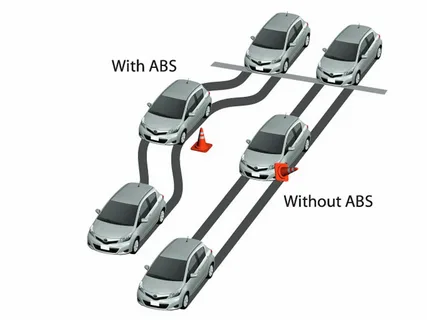The global Automotive ABS (Anti-lock Braking System) and ESC (Electronic Stability Control) Market is poised for significant growth between 2025 and 2035, driven by increasing vehicle safety regulations, technological advancements, and rising consumer demand for enhanced road safety.
The market, valued at USD 1,636.0 million in 2025, is expected to reach USD 3,467.1 million by 2035, expanding at a CAGR of 7.8% during the forecast period. The increasing adoption of advanced driver assistance systems (ADAS) and stringent safety mandates worldwide are key factors accelerating market growth.
As modern vehicles become more intelligent, connected, and performance-oriented, automotive safety systems are undergoing a parallel transformation. At the core of this evolution are Anti-lock Braking Systems (ABS) and Electronic Stability Control (ESC)—two technologies that have moved from optional upgrades to essential safety features, now considered the foundation of vehicular control in dynamic driving environments.
By combining mechanical control with digital precision, ABS and ESC systems are playing a pivotal role in reducing accidents, enhancing driver confidence, and supporting the broader vision of autonomous and intelligent mobility.
Get Ahead with Our Report: Request Your Sample Now!
https://www.futuremarketinsights.com/reports/sample/rep-gb-5292
ABS: Precision Braking in Critical Moments
ABS prevents the wheels from locking during hard braking, allowing the driver to maintain steering control while stopping. Originally developed for high-performance and commercial vehicles, this system has now become a standard feature across vehicle segments, significantly improving safety in emergency braking scenarios.
ABS works by rapidly modulating brake pressure in each wheel during sudden deceleration. This prevents skidding and maintains traction, especially on slippery or uneven surfaces. By helping vehicles stop safely without losing control, ABS reduces the likelihood of collisions and provides drivers with a greater sense of command during unexpected events.
ESC: A Safety Net Against Skidding and Oversteering
Electronic Stability Control takes safety a step further by detecting and mitigating loss of control. Using sensors that monitor steering angle, yaw rate, and wheel speed, ESC systems compare the driver’s intended path with the vehicle’s actual movement. If a mismatch is detected—such as during understeer or oversteer—the system automatically applies brake pressure to individual wheels and adjusts engine torque to restore stability.
ESC is especially effective in adverse weather conditions, sharp turns, or evasive maneuvers. It acts as an intelligent co-pilot, intervening only when necessary to keep the vehicle safely on course. Studies have consistently shown that ESC significantly reduces the risk of rollovers and single-vehicle crashes, making it one of the most impactful automotive safety technologies.
Integration with Advanced Driver Assistance Systems (ADAS)
Today’s ABS and ESC systems are no longer isolated components. They are integrated with broader Advanced Driver Assistance Systems (ADAS), including adaptive cruise control, autonomous emergency braking, and lane-keeping assistance. These integrations enable smoother transitions between human and automated control and lay the groundwork for higher levels of vehicle autonomy.
For example, ESC data is often used to support traction control systems (TCS) and hill-start assist functions. ABS plays a crucial role in automated braking responses during collision avoidance scenarios. This ecosystem of safety ensures that vehicles remain responsive, predictive, and protective in a wide range of driving conditions.
Applications Across Passenger, Commercial, and Electric Vehicles
ABS and ESC systems are now ubiquitous in both passenger and commercial vehicles. From city cars and sedans to heavy-duty trucks and buses, these technologies adapt to different braking systems and vehicle dynamics, enhancing safety across transportation modes.
In electric and hybrid vehicles, ABS and ESC systems are further optimized to work in conjunction with regenerative braking systems. The unique torque characteristics and braking behavior of EVs demand specialized calibration, ensuring that safety systems respond accurately and efficiently in electric drivetrains.
Challenges in Cost, Calibration, and Sensor Sensitivity
While widespread adoption has made these technologies more accessible, challenges remain. Accurate calibration of sensors across diverse vehicle types and real-world driving conditions is critical to ensure system reliability. Any error in sensor alignment or data interpretation can reduce system effectiveness.
Additionally, manufacturing costs and system complexity can pose barriers, particularly in low-cost vehicle markets. However, ongoing advancements in sensor technology, software algorithms, and system integration are helping lower these barriers and improve performance consistency.
Exhaustive Market Report: A Complete Study
https://www.futuremarketinsights.com/reports/automotive-abs-and-esc-market
Regulatory Momentum and Market Mandates
Global safety regulations have played a key role in driving ABS and ESC adoption. Many countries now mandate these systems in new vehicles, particularly in passenger and commercial segments. This regulatory push aligns with broader initiatives to reduce road fatalities and improve traffic safety worldwide.
Government incentives, safety ratings, and consumer awareness are also influencing buying decisions, with more consumers seeking vehicles equipped with advanced safety features—making ABS and ESC not just regulatory requirements but competitive differentiators.
A Cornerstone of Safer Mobility
As the automotive industry continues to pursue connected, autonomous, shared, and electric (CASE) mobility, ABS and ESC remain vital components of the safety architecture. Their ability to operate in milliseconds, predict vehicle behavior, and correct motion deviations makes them indispensable technologies for any future-ready vehicle platform.
With further integration into AI-driven safety systems, over-the-air updates, and real-time diagnostics, the next generation of ABS and ESC will be smarter, faster, and more adaptive—empowering safer driving experiences for all.
In a world where every second matters, ABS and ESC stand as silent protectors—working behind the scenes to ensure that every turn, stop, and maneuver is executed with precision, control, and confidence.


